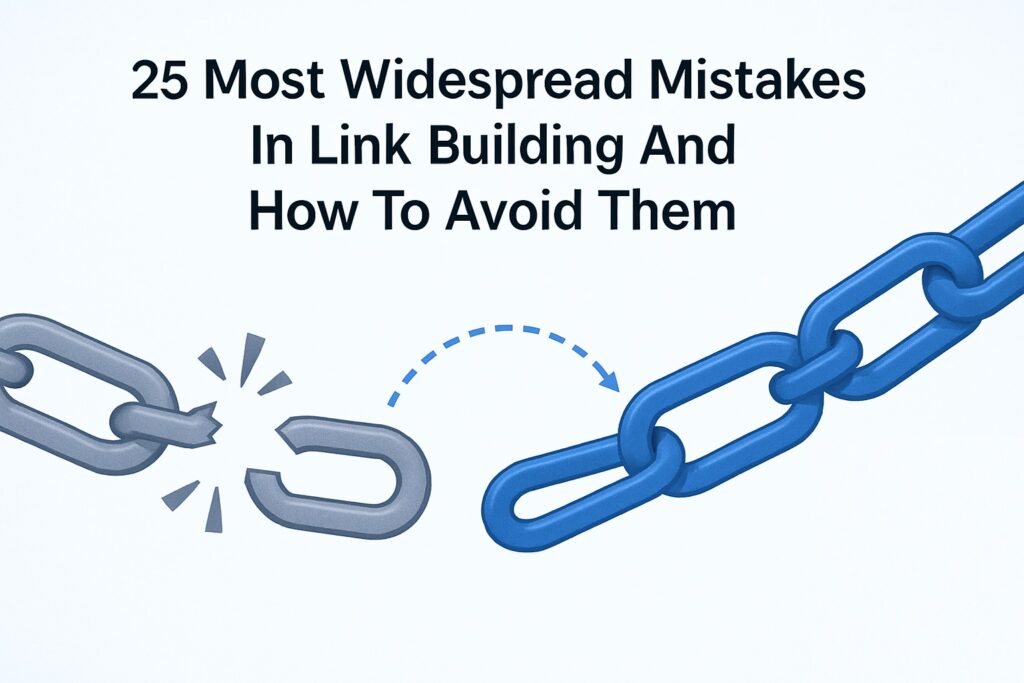Link-building involves several stages of serious work that follow and sometimes overlap with each other. But it also involves not taking certain steps that can potentially harm your own page. These wrong steps are called link-building mistakes and they can cost you money, time, and worst of all, reputation and ranking of your site – the things that you actually want to boost.
In this guide, we’ll look at all widespread mistakes in detail, see what the unwanted results can be, and decide on how to avoid them altogether. Avoiding these mistakes will help you build a healthy reputation for your site. It will also help it get higher ranking and an increase in traffic organically and sustainably.
If we were to give a very short roundup of all possible mistakes, we’d say they are:
- link-building promiscuity,
- link-building binging,
- and link-building negligence.
These names point to the underlying reasons why these mistakes are made, in the first place.
It’s OK if you don’t look through the list of all possible mistakes every time you plan the next step in link-building. Just always make sure to tick the following boxes in your mind at every important link-building stage:
- evaluate the link/domain quality by several parameters,
- don’t hoard links all at once,
- and watch closely if you are not missing any opportunity.
If you follow these simple rules the majority of following mistakes will simply never occur.
1. Backlinks Purchasing
By link purchasing, we mean literal buying of links in bulk from some obscure provider where you cannot control anything or evaluate the quality of the link-hosting content or a domain linking to your website. Usually, such links are of low quality because they lead to thematically irrelevant or scammy sites and content. In general, they look suspicious to algorithms, often because these links were dumped on your page(s) literally overnight.
In the mild case, Google will ignore these links and you’ll lose money on fake services. In the worst case, search engines will apply sanctions to your page (because it is an open breach of their guidelines) and demote the content you strive to promote.
To avoid this problem, team up with a reputable link-building company that uses white-hat methods only and builds links through relationships and careful referring domain selection.
2. Not Focusing on User Intent and Needs
If you provide certain types of services or sell certain products, you need to understand what your customers’ intent is. Then you will offer exactly what they need and every link leading to a targeted and informative piece of content will result in high traffic and high conversions. Understanding user intent will guide you to the optimal choice of referring domains and link-building tactics. Otherwise you’ll scatter your efforts in various directions with visible results.
Example? If your users’ intent is getting SEO marketing services, you need to team up with sites related to SEO and marketing and set up pages with content that matches this intent. So people from both domains will pull up to your page and find something useful. And it will bring you more organic links and more targeted traffic.
3. Taking the DR or DA Metric of a Prospective Domain As The Only Priority
Links from high-DR and -DA sites are seen as the most desirable, but DR alone is not a fully reliable metric. Domain rating can be manipulated if needed, and a site with DR70 can have the traffic limited to 30 people per month! Obviously, that’s not the domain to link to, so always check traffic and other useful metrics (like the number and quality of backlinks) before building a link connection to a webpage.
The unwanted result of focusing on DA/DR of a domain only will be sanctions from Google for hosting spammy links. Plus, it is a loss of potential traffic that would otherwise have been available if you had linked to a really authoritative and popular page.
4. Placing Links Only On The Main Page
This mistake will cost you several lost opportunities at once. First, you can fit on the main page only so many links without making it look over-spammed.
Second, it’s more reasonable and convenient to build diversified links from different sources to a number of thematic pages on your site like blog posts, guides, product description and comparison pages, and so on. You’ll drive traffic to them, reduce bounce rates and increase conversions. This move is totally natural and will never raise suspicions with search engines.
Finally, you are free to build internal links between deep pages, creating a clean and easily navigable website. Google evaluates the internal linkwork of a site and rewards well-structured ones with better ranking and visibility.
So instead of focusing on a landing page only, build healthy internal and external links to as many pages of your site as you can (preferably to each one to make them accessible to users).
5. Misuse of Internal Links
Internal links mistakes are closely connected to the previous case. Internal links contribute to the growth of website position, so ignoring them is already a mistake. A website should feature a coherent structure of connected pages that lead from product to product or from a product to related items or accessories. Carefully built internal links help retain people on a website and increase viewing time.
So while creating internal links, make sure there are no orphan pages and all links are workable. It will contribute both to user experience and to a positive shift in the website exposure and ranking. Google moves well-organized pages up and offers them to users as more relevant, and does not make a secret out of it.

6. Focusing on Dofollow Links Only
Although Google uses dofollow links for site ranking and mostly ignores nofollow links in the process, they subtly count towards the general page reputation and validity in the eyes of search engines.
Nofollow links were introduced specifically to combat link spamming in blogs’ and forums’ comments because initially, this tactic worked and the flood of spammy links pushed some suspicious or irrelevant resources to the top. Pages with valuable content and comment moderation were thus demoted in search listings in their thematic niche. To prevent the problem, Google started tagging links in certain contexts as ‘nofollow’ and removed them from the ranking estimation process.
However, the presence of nofollow links shows that the website is a full-fledged resource with various types of content and a good deal of value for users. Nofollow links leading to the page from authoritative or popular resources (established media, authoritative niche websites, etc.) also pass link authority. They also show Google that the site is operating and developing actively in a given niche and is a reliable source attracting organic links and mentions.
So if you can obtain nofollow links from sources with high reputation and weight in your industry, do it without hesitation.
7. Spamming Links in Forums or Blog Comments
We intentionally place this mistake next to the backlink mistakes with nofollow because they are actually two sides of one coin. Nofollow links were designed to prevent fraud with link flooding in blog comments. At first, this grey tactic worked successfully, redirecting targeted traffic from reputable sources to random ones. That’s why now this tactic is considered black-hat and it does not work anymore. No matter what some link-building entities may tell you, placing links to your page in comments at random blogs will only damage the reputation of your page and move it into the ‘grey pages’ zone in Google rating. So don’t engage in this practice.
Reddit links, due to the organic authority of the resource, may bring some value to your page, but only a very limited amount of it, so don’t rely on it as a serious link-building move.
8. Private Blog Network (PBN) is a Red Flag for Google
This is a network of small blogs specifically created for manipulating link building and implementing SEO practices in industries where traditional methods may not work. Such blogs may have a varying degree of success as link providers because Google is adept at detecting these networks. If an algorithm decides that there is a manipulation going on there, a site linking to these blogs may lose its hard-earned positions in ranking.
Yet there is a bright side: if you operate in high-margin industries like online casinos where other types of links are hard to get, a topically matching (that’s important!) PBN can be of help. Carefully crafted links that lead from these niche media to your site can generate targeted traffic and boost the ranking because the PBN user’s intent and your content under the link align. But the links and the topic niche of this PBN need to match with the theme of your site – and your content to which they lead needs to look professional and useful.
9. Focusing on a Single Link-Building Tactic
Diversified approach is a key to success in any complex business, link-building included. If you use only one way to gain backlinks, like broken link building or exploring the competitors’ link profile, you miss a lot of opportunities. So use both, plus prospect the links with the leading websites and resources in your niche.
Another mistake is to focus on one source of links, like industry influencers, niche media, or listicles on the thematic resources. The naturally looking link profile should feature everything, including mentions in press releases and on social media, links from influencers, content-based links, links in niche listing compilations, and so on. Each tactic hosts an array of opportunities, so every new tactic you apply diversifies your portfolio and increases the useful link mass.
10. Relying on HIghly-Optimized Anchors Only
It’s tempting to put links under anchors with exact keyword matches, but Google does not approve of keyword staffing in links anymore. Links in the single text need to be hidden under various anchors, including generic text like ‘click here’ and ‘read more’, partial keyword match, exact keyword match, brand names, naked URLs, and combinations of these elements. This approach will make everything look organic and written with user needs in mind. Backlink mistakes with anchors that look like exact keywords only will make the page look spammy and reduce its value in Google’s evaluation.
11. Link-Building Fails with URLs
There are several types of mistakes one can make with URLs. The first one is not using naked URLs as anchors in the text. The optimal combination is using exact keywords, optimized link anchors, domain name, and naked URLs across the text. It looks natural and gives more clues as to what content is under that link. Naked URLs are URLs of the content you link to, like, for example, www.marketing-company.com/article-about-linkbuilding or bigcompany.com/linkbuilding-for-beginners. Choose the shorter URLs for the text to look neater, where possible.
Another type of backlink mistakes with URL is related to the URL structure. There is an ongoing debate whether to use www or not and what is better, http or https. The answer is, look at the actual structure of your URL and use it as it is. If Google ultimately redirects the users to the ‘https’ version of the URL, use this https version. Redirection creates extra work for Google, which makes room for possible glitches.
Plus, Google treats http and https versions of the page as two separate entities which may result in content duplicates when someone clicks the link. So instead of building a useful link, you create more troubles for Google with your site structure.
12. Getting Random Links Not Related To The Content Topic
At the beginning of the site promotion, every link counts, so the incentive to get random links from high-DA and -DR pages is also high. Yet when the first round of link-building is over, it’s necessary to run the inventory of your links and remove the irrelevant ones. Links that lead to your site from non-related pages, like a link from a construction company to a SEO page, bring no traffic and potentially damage the reputation of your page as spam. Links in overlapping niches, like SEO and site-building, work well and bring cross-traffic as well as authority to your page. Completely irrelevant links do more harm than good in the long run.

13. Collaborating with Low-Quality Directories
Directories provide access to services and products people need, so getting mentioned by such a directory is a boon for a business. Yet a directory needs to be popular and rich in organic traffic to pass real value through the link. Many directories accept entries for money, and the whole affair looks like a link farm disguised as something else, in the first place. Such link placement may again do more harm than good because instead of bringing traffic and authority it will signal to Google about potentially illegal SEO practices.
So before engaging with a directory, explore its reputation and decide if the risk is worth it.
14. Getting Links from Link Farms
Link farms are sites that are created specifically for selling links. They may look like legit resources, but their content and structure are anything but. These sources don’t provide much value in their articles or other types of content, and each piece is over-spammed with links unrelated to the text point.
If private blog networks are easier to detect, then link farms are standalone entities that may fly under the Google radar. Yet the problem with these sites is that they disappear after a year or so, so any link you got from them becomes a broken one. Plus, you love money invested into those links, which can accrue to thousands of dollars. In the worst case, Google detects the fake nature of a link farm and puts it into a shadow ban, thus damaging your link profile.
15. Using Standardized Outreach Emails Indiscriminately
Sending emails to website owners who can provide backlinks should not be aggressive impersonal email marketing, because they most probably get dozens of such emails daily. Modern email building is about creating community and building mutual reputation by exchanging links that lead to valuable content. So instead of sending tons of identical letters, craft emails fine-tuned to niches of the resources you try to get links from. Show them that you appreciate their efforts and reputation and want to contribute something valuable specifically for them.
Definitely you’ll operate in niches directly related to your own, but there is some breathing room to try different subtopics and approaches. Site builders will appreciate content related to site-making, i.e. how to account for future SEO needs while creating the site structure, for example. Marketing pages will eagerly link to content about SEO marketing, and so on. So diversify your emails and the value you offer. It will pay back manyfold.
16. Not Caring About Relationships in Link Building
As it’s obvious from the previous point, many backlinks mistakes can be avoided if you start with the idea of relationships and the creation of friendly collaborative relationships. It means establishing sincere rapport with other players in the field and showing them that you can deliver value to their users. Once they know it, you can begin link-building. Gradually, from one link that generates traffic for you and adds to the value of their own page as a good content provider, you can progress to regular link exchange that will strengthen your positions in your niches. Value begets value, and their good reputation supports your good reputation and vice versa, plus they can recommend you to other resources with good reputation. But it all begins with open and respectful relationship building.
17. Not Caring about Content Quality
It all begins with relationships and the link but ultimately ends – or develops – with the content you create. One of the silliest mistakes you can make is not paying attention to the content on your site. You may get a link from the most reputable source out there, but if your content under that link is worth nothing, your link value will also perish without a trace.
If you regularly publish fresh and insightful articles and other types of content, people will return for more even without seeing a link elsewhere. Additionally, an interesting and SEO-optimized article will attract users on its own. But put together, a high-value link and good content will generate an endless stream of targeted traffic and attract more and more users.
18. Missing the Broken Links Opportunity
This tactic brings many valuable link-building opportunities that otherwise would just disappear. It’s important to audit your site for broken links while prospecting your competitors and leading websites in the field for any missing links. While performing broken link building, you start building a community of people whom you actually helped, and from there, the new link collaborations that stem from mutual benefits begin.
In the language of numbers, every broken link on a popular site that you helped to revive will bring you a 2%-3% increase in traffic and gradual but steady improvement in ranking.
19. Chasing Quantity Instead of Quality
The point of getting links is not links per se, but the advantages for your site and your business they can bring. That’s why focusing on link quality matters. By quality, we mean links coming from really powerful players in the field, with tons of traffic and authority they can pass to you. Instead of chasing any link and spending time and money, evaluate what links are the most useful and valuable. With a few backlinks from sites with the real (not fake) DR70+ you’ll get better ranking and influx of traffic than with dozens of links coming from some obscure resource.
20. Trying to Get the Perfect Link Only
That’s the point of balance you need to learn to achieve in link prospecting: not chase any first best link opportunity and not lose the chance to create a good link. A perfect link has it all – absolute relevance for you, DR 80+, and the traffic that approaches a million users’ benchmark. Such links are rare, and you cannot fill your site with such links only. So get various types of links, and use common sense while choosing – one link may come from a high DR site and match your topic, others may come from sites with tons of traffic that loosely relate to your niche (but still relate), and so on. Taken together, they’ll create the necessary impression of a professional and interesting resource that attracts all kinds of users. And that’s the foundation of unshakable and ever growing authority in your field.
21. Building A Huge Bulk Of Links In A Short Time
This mistake is often made by novices in link-building (and SEO as such). Organic accumulation of links happens over time, dozens of links per month, sometimes hundreds, and then over a year, the count in thousands begins. If a huge number of links appears out of nowhere and without a related spike in traffic, like it sometimes happens when a post goes viral, Google will flag them as suspicious or fake links. As a result, the site will lose its ranking position and see decline in traffic.
22. Failing To Do Local And Geo-Targeted Link Building
Businesses that operate in specific locations will especially benefit from this move. Getting mentions from local bloggers or featuring in local news outlets or directories will drive local traffic to your page. If you have a physical office or showroom there, the local link building is a must. Global clientele is fine, but getting local attention is priceless in many respects, since it will draw people into your shop. By not doing it, you actually lose clients who can bring more clients by virtue of grapevining.

23. Relying On Automated Link Building Blindly
WP plugins and standalone tools like Yoast and Ahrefs link checkers can help in detecting broken links or finding pages without links. But don’t rely on them in automatic link insertion. The automated tools often stuff the text with exact match anchors, thus making it look spammy. Additionally, they don’t detect the exact context of the article and can suggest placing internal links between pages that are not strongly related. So the internal link structure will become lame. To avoid it, always check the anchor and the content before accepting the link suggestion.
24. Not Looking Into Competitor’s Backlink Profile
Some SEO professionals advise not to get involved with competitors’ link profiles because they have already occupied the niche and so it’s useless to try and get there. However, by analyzing their backlinks, you tap into the pool of useful and reputable resources that you can try and get links from. Tools like Ahrefs or SEMrush will help to locate links and the referring domains, and then it’s time to create valuable content and pitch it smartly to those resources. There is always something new to say or some valuable experience to share, so even if you compete in the same niche, the content and delivered value will differ. And if you know the user intent really well, you will outsmart your competitors in content creation.
25. Not Following The Search Engine Guidelines And Updates
As said, Google and other search engines that decide on the fate of your website change their rules and limitations to match the developments in SEO practices. Nofollow links were developed exactly to stop the link spam in blogs and forums. This point is valid for many other changes in search engine policies. So always get updated on the latest tendencies and changes before planning the next big link-building step. There are many authoritative sources out there that bring you the most important information in digestible form. So stay informed and don’t make a blunder just because you didn’t read the latest Google policy update.
Conclusions
We’ve compiled an extensive list of backlinks mistakes you can make, but the best way to avoid them all is to apply some common sense. At the beginning we’ve mentioned the points to keep in mind – evaluate sites you link to, don’t try to get all links in the world, and think where you might miss an opportunity. Yet it’s always handy to have the checklist to look through, so keep this article in tabs and consult it when in doubt. With some patience and practice, you’ll work out your own successful strategy and will grow the link mass steadily.
